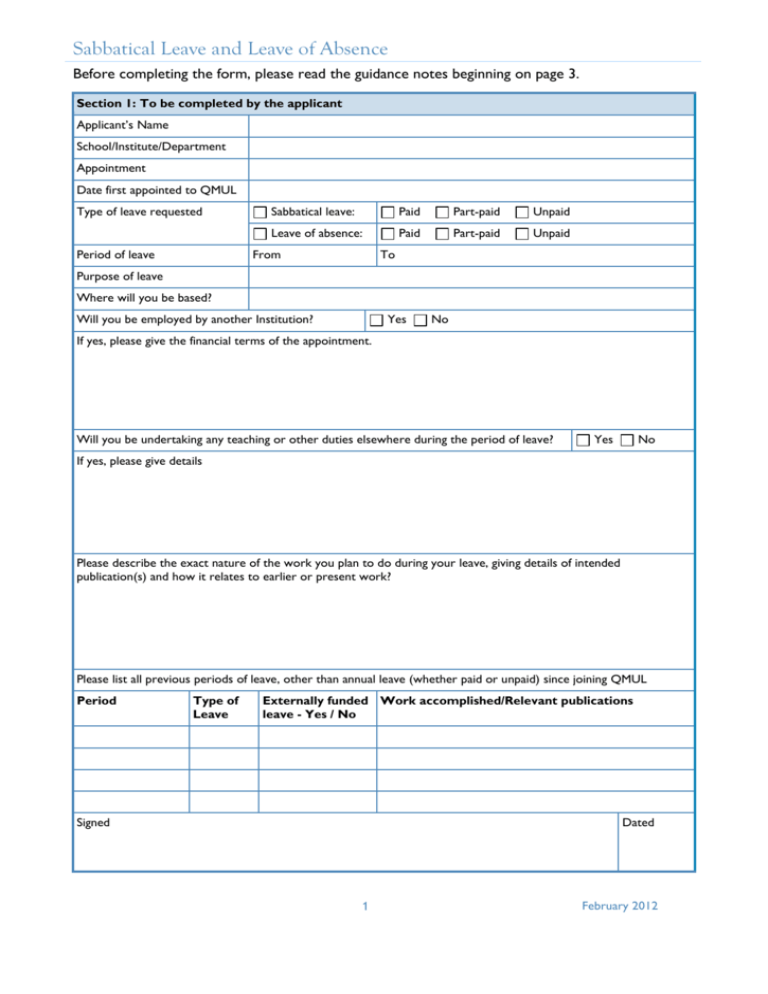Application for sabbatical leave
advertisement

Sabbatical Leave and Leave of Absence Before completing the form, please read the guidance notes beginning on page 3. Section 1: To be completed by the applicant Applicant’s Name School/Institute/Department Appointment Date first appointed to QMUL Type of leave requested Period of leave Sabbatical leave: Paid Part-paid Unpaid Leave of absence: Paid Part-paid Unpaid From To Purpose of leave Where will you be based? Will you be employed by another Institution? Yes No If yes, please give the financial terms of the appointment. Will you be undertaking any teaching or other duties elsewhere during the period of leave? Yes No If yes, please give details Please describe the exact nature of the work you plan to do during your leave, giving details of intended publication(s) and how it relates to earlier or present work? Please list all previous periods of leave, other than annual leave (whether paid or unpaid) since joining QMUL Period Type of Leave Externally funded Work accomplished/Relevant publications leave - Yes / No Signed Dated 1 February 2012 Sabbatical Leave and Leave of Absence for Academic Staff Section 2: Statement by Head of School or Institute/Director of Department Applicant’s Name I support the application for leave I do not support the application for leave Please give reasons, including details of the applicant’s previous published work Please explain how the School/Institute/Department will provide for the applicant’s teaching, administrative, examining and supervisory duties if leave is granted. You must ensure that leave is planned so that the effective operation of the School/Institute/Division is assured. If the applicant is a Clinical Academic holding NHS contracts please canvass and give the view of the NHS provider. Please explain any budgetary implications Signed Name: School/Institute/Department Date: The Next Step When Sections 1 and 2 of the form are both complete, please take and keep a copy and forward the original to the relevant HR Administrative team, who will ensure that it is submitted to the Principal (or his or her nominee) for decision. 2 February 2012 Sabbatical Leave and Leave of Absence for Academic Staff Guidance Note Please complete Section 1 of the application form and forward it to your Head of School or Institute/Director of Department. They will complete Section 2 of the form. All applications must be submitted indicating explicit dates for the proposed period of absence. Applications for sabbatical leave in Semester 1 should be lodged with the Faculty Vice Principal via HR by the end of Semester 1 of the preceding year. Applications for sabbatical leave in semester 2 should be lodged with the Faculty Vice Principal via HR by the end of semester 2 of the preceding year. Leave Of Absence This document should be read in conjunction with Appendix 1 to the Conditions of Service for Academic Staff: Sabbatical Leave and Leave of Absence which are attached. 1 Leave of absence, particularly where salary is continued and the time is to be devoted to research, is an important feature of College life and follows directly from QMUL’s Mission Statement. It serves not only to reward and motivate staff, but above all to promote QMUL’s research output, which is vital to QMUL’s future. It is therefore important that leave should be granted on a fair and equitable basis across QMUL. 2 Leave of absence is defined as a period during which a member of staff is released from all normal duties to concentrate on particular work, which will normally have been described in the application for leave. The staff member is normally free to work anywhere and is not required to attend College. Leave of this kind may, however, be subject to a requirement to perform certain duties or tasks. 3 Members of staff may be required to carry out College duties elsewhere for example, attendance at certain conferences or meetings, international student recruitment trips, research activity funded by grants paid to QMUL (such as physicists working at CERN in Geneva or astronomers visiting overseas telescopes). Strictly speaking, such visits of reasonably short duration do not constitute “leave of absence” at all, but they do require the approval of the Head of School or Institute/Director of Department, which should be properly recorded in writing and filed. Heads should be careful not to confuse such “approved absences” with cases where leave of absence is required. 4 Leave of absence of all kinds (paid and unpaid) can be granted only by the Principal (or his or her nominee, normally the Faculty Vice-Principal). In no circumstances is the granting of leave of absence delegated to Heads of School or Institute/Director of Department, even where replacement teaching or cover for other duties are not required. 5 There are three kinds of leave of absence: a Leave without pay [see paragraph 6 below] b Leave with pay “sabbatical leave” [see paragraph 7 below]. c Leave with pay outside the member of staff’s entitlement [see paragraph 9 below]. In addition, the Head of School or Institute/Director of Department has the power to reallocate duties [see paragraph 10 below]. 6 Leave of absence without pay may be granted to enable the member of staff to pursue a research project funded by another body, to undertake a paid position elsewhere, e.g. as visiting professor or on secondment, or for personal or compassionate reasons. The Principal (or his or her nominee, normally the faculty Vice-Principal) will have regard to the value to be derived by the individual and by QMUL following the period of leave, the needs of the School/ Institute/Department, the length of leave requested, and any previous periods of leave, paid or unpaid. It is not the case that an application for unpaid leave will necessarily be successful because QMUL makes a saving on the salary. Where an application is to be submitted to an outside body for support that will give rise to an application for unpaid leave, it is essential that this should be discussed with the Head of School or Institute or Director of Department prior to submitting the formal application to the outside body. The Head of School or Institute or Director of Department may wish to consult the Principal (or his or her nominee, normally the faculty Vice-Principal) informally. Payment of USS contributions during a period of unpaid leave is covered by paragraph 2.3 and 2.4 of Appendix 1 to the Academic Terms and Conditions (attached). 7 Leave of absence on full pay – Sabbatical Leave may be granted to enable the member of staff to pursue research (or, rarely, a course of study). Approval of sabbatical leave is subject to “the academic merits of the application”. This refers not only to the quality of the proposed project but also the applicant’s ability, based on past performance, to complete the project satisfactorily. The Principal or his or her nominee will normally expect to see a successful track record of research and publication before granting sabbatical leave. Those who have held 3 February 2012 Sabbatical Leave and Leave of Absence for Academic Staff demanding administrative or managerial posts, such as Head of School or Institute, Director of Department, Dean or Vice-Principal, will have this taken into account in dealing with an application. 8 Leave of absence on full pay other than sabbatical leave or in excess of a sabbatical leave period , may be granted in exceptional circumstances. 9 The granting of leave of absence of any kind has no automatic implications for a replacement or for the provision of funds for supplementary teaching or to provide cover for any clinical service responsibilities. The general expectation with respect to paid leave is that neither a replacement nor additional funds will be provided, but there may be circumstances when a replacement or some bought-in teaching will be necessary. Each case will be considered on its merits. In cases of unpaid leave, the Head of School or Institute/Director of Department is advised to consult their faculty Vice-Principal first on the subject of any replacement teaching or supplementary funds before making a recommendation to the Principal acting on behalf of the Staff Policy Committee. 10 The Head of School or Institute or Director of Department has the power so to allocate teaching and other duties at a particular time that a staff member is given more time to devote to a particular research project or piece of writing. For example, a staff member may have a heavier teaching load in one term to permit a lighter load, or even no load, in another. A member of staff benefiting from such a re-allocation of duties is nevertheless expected to continue administrative duties, supervision of research students and to attend at QMUL for departmental meetings and the like. There is thus a very clear distinction between leave of absence, which only the Principal (or his or her nominee) can grant, and a re-allocation of duties to allow additional research time, which lies within the normal discretion of a Head of School or Institute/Director of Department 11 The Head of School or Institute/Director of Department is encouraged to make use of this flexibility in order to maximise department/division’s research output. 12 At the end of the period of leave, a report summarising the work / research undertaken should be submitted to the Principal (or his or her nominee). The report is due within 1 month of the end of the agreed period of leave. 4 February 2012 Sabbatical Leave and Leave of Absence for Academic Staff Appendix 1 to the Terms and Conditions of Academic Staff 1. 1. 2. 3. 4. 5. 6. 7. 2. 1. 2. 3. 4. 5. 3. Introduction QMUL regards sabbatical leave as most important to the personal and career development of members of the Academic Staff. If you are on a “permanent” contract you may apply for sabbatical leave that will benefit teaching and/or clinical activity through scholarship and/or study. All staff will normally be expected to serve a continuous period of six semesters after appointment before they are eligible for sabbatical leave. Staff on probation will not normally be eligible for sabbatical leave until they have satisfactorily completed and passed their probation After completing a period of internally funded sabbatical leave, staff will normally be expected to serve a further six semesters of normal duties before being eligible to apply for a further period of College funded sabbatical leave. Any periods of externally funded leave will not be counted toward that six-semester qualifying period. Externally funded periods of research leave do not replace College funded leave, nor do they reduce entitlement to College- funded leave ( six months after six semesters of normal contribution including teaching), but they do not count as part of the qualifying six semesters on which entitlement to apply for College leave is based. Periods of maternity leave and sickness absence do count towards the six semesters Approval of Sabbatical Leave and Leave of Absence is at the discretion of the Principal (or his or her nominee, normally the faculty Vice-Principal). Approval depends on: a) the academic merits of your application; and b) the total amount of sabbatical leave, which must not exceed two semesters within seven years; or alternatively one semester within seven semesters. Financial Arrangements Sabbatical leave is normally granted on full pay, on condition that the member of staff is not in receipt of other remuneration. Leave of absence other than sabbatical leave may be on full, part or nil pay, depending on the merits of the application. During periods of part pay QMUL will meet your share of USS contributions. During periods of unpaid leave QMUL will meet the amount of your share of USS contribution as required by current legislation. For applications from the School of Medicine and Dentistry: it may be necessary to explore with the Trust how to make financial arrangements for locum cover - if NHS duties cannot be covered from reallocations of staff within the Clinical Academic Unit. Procedure 1. All applications must be submitted indicating precise dates for the proposed period of absence. Applications for sabbatical leave in Semester 1 should be lodged with the Faculty Vice Principal via HR by the end of Semester 1 in the preceding year. Applications for sabbatical leave in semester 2 should be lodged with the Faculty Vice Principal via HR by the end of semester 2 of the preceding year. 2. Sabbatical leave: the Principal (or his or her nominee, normally the faculty Vice-Principal) will consider the timing of any leave requested and the need for any replacement teaching provision taking into account the recommendation of the Head of School/Institute. Individuals may be asked to delay a period of leave in the light of these considerations. 3. Leave of Absence: On full- pay; part pay; or nil pay may be granted in addition to or instead of sabbatical leave. 4. Approval for Leave of Absence: The Principal (or his or her nominee, normally the faculty Vice-Principal) will consider your application taking into account its academic merit, your length of service and previous periods of leave. Submit your application to the relevant HR Administrative Team. Include the recommendation of your Head of School/Institute and a statement of any replacement teaching requirements. Include such comments even if you are the Head of School/Institute applying in your own behalf. 5 February 2012







